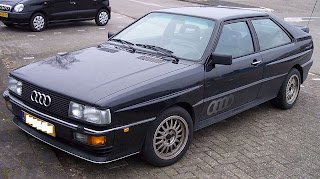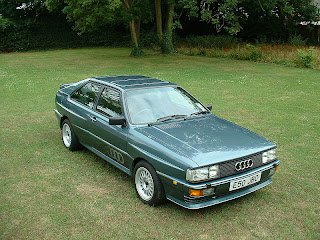The word quattro is derived from the Italian word for “four”. The name has also been used by Audi to refer to the quattro four-wheel drive system, or any four-wheel drive version of an Audi model. To avoid confusion, the original Quattro model is also commonly referred to as the Ur-Quattro – the “Ur-” (German for “primordial” or “ancestral”) is an augmentative prefix, in this case meaning “original”, and is also applied to the first generation Audi S4 and Audi S6 models, as in “Ur-S4” and “Ur-S6”.
The Audi Quattro was the first rally car to take advantage of the then-recently changed rules which allowed the use of four-wheel drive in competition racing. It won competition after competition for the next two years. To commemorate the success of the original vehicle, all subsequent Audis with their trademark quattro four wheel drive system were badged “quattro” with a lower case “q”. The original car with the upper case “Q” in the Quattro nts and the core of its body style with the Audi Coupé, which was a member of the Audi 80 (B2) model range. It was internally designated Typ 85, a type number it shared with the Audi Coupé GT, Audi Coupé quattro and Audi 4000CS quattro. Its characteristic flared wheelarches were styled by Martin Smith. The Audi Quattro also had independent rear suspension and independent front suspension.
European market
Audi released the original Quattro to European customers in late 1980,[1] making it both the first car to feature Audi’s quattro permanent four-wheel drive system (hence its name), and the first to mate four wheel drive with a turbocharged engine.[
The original engine was the 2,144 cc (131 cu in) (2.1 L), inline-5 cylinder 10 valve SOHC, with a turbocharger and intercooler. It produced 147 kW (200 PS; 197 bhp) and torque of 285 N·m (210 ft·lbf) at 3500 rpm; propelling the Quattro from 0-100 km/h (62 mph) in 7.1s, and reaching a top speed of over 220 km/h (137 mph).[1]
The engine was eventually modified to a 2,226 cc (136 cu in) (2.2 L) inline-5 10 valve, still producing147 kW (200 PS; 197 bhp), but with peak torque lower in the rev-range.[1] In 1989, it was then changed to a 2,226 cc (136 cu in) inline-5 20v (2.2 L 20v) DOHC setup producing 162 kW (220 PS; 217 bhp), now with a top speed of 230 km/h (143 mph).[1]
Audi Quattros are often referred to among owners and enthusiasts by their engine codes, to differentiate between the earlier and later versions: the earliest 2144 cc 10v being the “WR” engine, the 2226 cc 10v being the “MB” engine, and the later 20v being the “RR” engine. Hence, Quattro models may be referred to as either the WR Quattro, MB Quattro, and RR or “20v” Quattro, respectively.
Quattro car production was 11,452 vehicles over the period 1980–1991,[1][2] and through this 11 year production span, there were no major changes in the visual design of the vehicle. For the 1983 model year, the dash was switched from an analogue instrument cluster, to a green digital liquid crystal display (LCD) electronic instrument cluster. This was later changed in 1988 to an orange LCD electronic instrument cluster. The interior was redesigned in 1984, and featured a whole new dash layout, new steering wheel design, and new centre console design, the switches around the instrument panel were also redesigned at this time. In 1985 the dash changed slightly with harder foam and lost a diagonal stripe, the dash switches were varied slightly and the diff lock pull knob gave way to a two-position turning knob with volt and oil temp digital readouts.
1987 MB engined Audi quattroExternal styling received very little modification during its production run. Originally, the car had a flat fronted grille featuring four separate headlamp lenses, one for each of the low and high beam units. This was altered for the 1983 model year, and replaced with combined units featuring a single lens, but housing twin reflectors. This was changed again, for the 1985 model year, in what has become known as the ‘facelift model’ and included such alterations as a new sloping front grille, headlights, and trim and badging changes. The RR 20v Quattro also featured a new three spoke steering wheel design, leather covering for door arm rests, gloveboxes, centre console and door pockets. There was also a full length leather wrapped centre console running all the way to the rear seats. 20v was also the first Ur-Q to have “quattro” script interior with partial leather seats. The floor on the drivers side had a bulge due to dual catalytic exhaust setup. The different models may be distinguished by the emblems on their boot lids: the WR had a vinyl ‘quattro’ decal or a brushed aluminium effect plastic emblem, the MB had chrome plated ‘audi’, ‘audi rings’ and ‘quattro’ emblems, whilst the RR had only chrome plated ‘audi rings’.
The rear suspension was altered early on with geometry changes and removal of the rear anti-roll bar to reduce a tendency for lift-off oversteer. For the 1984 facelift, the wheel size went from 6×15″ with 205/60-15 tyres to 8×15″ wheels with 215/50-15 tyres. At the same time the suspension was lowered 20mm with slightly stiffer springs for improved handling. For 1987, the Torsen centre differential was used for the first time, replacing the manual centre differential lock.
North American market
US/Canadian cars were also equipped with larger impact bumpers with built in shock absorbers, just like the rest of the 4000/Coupé models. None of the cars came with Anti-lock Braking System (ABS), however they were otherwise “loaded” with options, including air conditioning, and in 90% of the cars, leather upholstery. Most of the 1984 and 1985 Canadian models did not have sunroofs. The remainder of the electric, suspension and cosmetic updates took place at the same time as the European cars. Out of 99 cars imported to Canada 35 are still known to be on the road.
The initial 2.1L (2144cc, engine code “WX”) engine for US/Canadian models included minor component and engine control unit (ECU) changes, including lowered turbocharger boost pressure, different camshaft, emission controls including catalytic converter, and lambda stoichiometric fuel control, which lowered power to 160 hp (119 kW; 162 PS). Otherwise, mechanical specifications were identical to the European spec cars. The WX engine was also used on Swiss and Japanese market cars. In fact Audi built 200 special edition cars in 1988 with WX engine and analogue instruments, the rest of the car was identical to the MB cars of that year.






